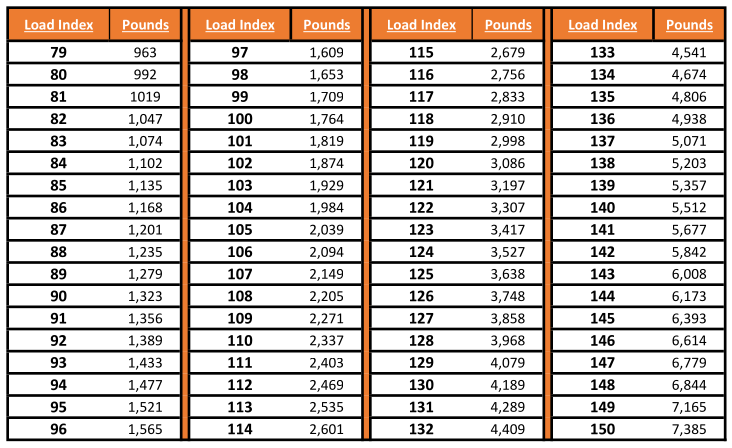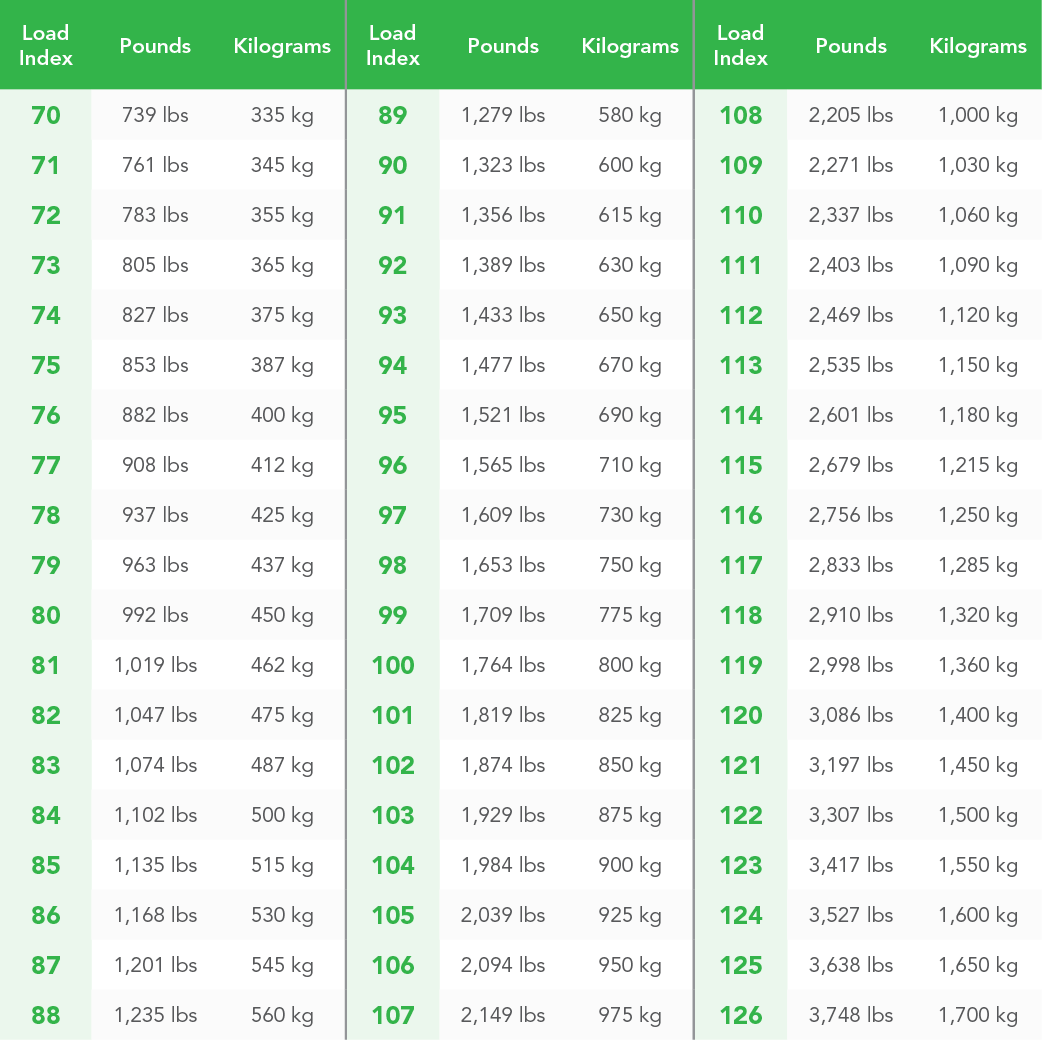The tire load index is a numerical value found on a tire’s sidewall that indicates the maximum weight a tire can support when properly inflated. The higher the number, the more weight the tire can carry. It is important to choose tires with the correct load index for your vehicle to ensure safety, optimal performance, and even tire wear. Exceeding a tire’s load index can lead to tire failure, poor handling, and reduced lifespan.
Tires are one of the most important components of a vehicle, and understanding their specifications is crucial for safety, performance, and longevity. Among the essential tire specifications is the tire load index—a number that indicates the maximum weight a tire can support. While it may not be the first thing you check when buying tires, getting the correct load index is vital to ensuring that the vehicle operates safely, especially under heavy loads or during long trips.
In this comprehensive guide, we will explore what the tire load index is, how it works, why it matters, and how to choose the right tire load index for the vehicle. We’ll also look at how tire load index impacts performance, tire longevity, and vehicle safety.

Credit: simpletire.com
Contents
What is Tire Load Index?
The tire load index is a numerical code on the sidewall of a tire that specifies the maximum weight the tire can safely carry when properly inflated. It is part of the tire’s overall rating system, which includes other important indicators like speed rating, tire size, and construction type.
The load index number corresponds to a specific weight capacity in pounds or kilograms. For example, a tire with a load index of 91 can carry up to 1,356 pounds (615 kg) per tire. If a vehicle has four tires with a load index of 91, the total maximum load capacity would be 5,424 pounds (2,460 kg), assuming the tires are properly inflated and in good condition.
The tire load index is usually located on the tire’s sidewall, next to the tire size information. For example, in the code “P215/65R15 91H,” the number 91 represents the load index, while the letter H represents the tire’s speed rating.
How Does the Tire Load Index Work?
Each number in the tire load index corresponds to a specific weight that the tire can support. The higher the number, the more weight the tire can carry. The load index typically ranges from 70 to 126 for most passenger cars and light trucks, although tires for heavier vehicles like commercial trucks may have even higher load indexes.
Below is a simplified tire load index chart with some common load index numbers and their corresponding weight capacities:
| Load Index | Max Load (lbs) | Max Load (kg) |
|---|---|---|
| 75 | 852 lbs | 387 kg |
| 80 | 992 lbs | 450 kg |
| 85 | 1,135 lbs | 515 kg |
| 90 | 1,323 lbs | 600 kg |
| 95 | 1,521 lbs | 690 kg |
| 100 | 1,764 lbs | 800 kg |
| 110 | 2,337 lbs | 1,060 kg |
To calculate the total load-carrying capacity for the vehicle, multiply the tire’s load index rating by the number of tires on the vehicle. For instance, if each tire has a load index of 100, you can calculate the total load capacity for four tires as:
1,764 lbs x 4 tires = 7,056 lbs
This means the tires can safely support a total vehicle weight of up to 7,056 pounds, including passengers, cargo, and the vehicle itself.
Why Tire Load Index is Important
Choosing the right tire load index is critical for several reasons. Here’s why the load index matters and how it affects the vehicle:
1. Safety
The tire load index directly impacts the vehicle’s safety. Overloading tires beyond their rated capacity can lead to excessive heat buildup, blowouts, or premature tire failure. A blowout at high speed, especially in a fully loaded vehicle, can be dangerous and lead to loss of vehicle control, accidents, or injury.
2. Tire Performance
The load index also affects how a tire performs under different conditions. Tires with a higher load index are designed to carry more weight, which can make them stiffer and less flexible. This could impact handling, braking, and ride comfort. If the load index is too low for the vehicle, the tires may wear out faster and have poorer traction, particularly when the vehicle is loaded.
3. Fuel Efficiency
Tires with a higher load index tend to have thicker, heavier constructions to support greater loads, which can increase rolling resistance. This means the vehicle may require more fuel to move, decreasing overall fuel efficiency. On the other hand, tires with a lower load index might offer better fuel efficiency but may not support the load safely, especially if you regularly haul heavy cargo.
4. Legal Compliance
In many regions, it is illegal to use tires with a load index that is lower than the manufacturer’s recommendation for the vehicle. If you’re using tires with an inadequate load index, it can void warranties, fail vehicle inspections, and result in fines. Always consult the vehicle’s manual or the tire placard on the driver’s side door jamb to find the correct load index for the vehicle.
How to Choose the Right Tire Load Index
Selecting the correct tire load index is crucial to maintaining the safety and performance of the vehicle. Here are the steps to ensure you choose the right one:
1. Check the Vehicle Manufacturer’s Recommendations
The best place to start is the vehicle’s owner’s manual or the tire placard located on the driver’s side door jamb. This will provide the recommended tire size, load index, and speed rating for your vehicle. The recommended load index is the minimum rating the vehicle needs for safe operation.
2. Consider the Type of Driving and Load
Think about how you typically use the vehicle. If you frequently carry heavy loads, tow trailers, or drive off-road, you may want to opt for a higher load index for added safety and durability. For example, heavy-duty trucks or SUVs used for towing may require tires with a load index of 110 or higher.
For everyday driving with minimal cargo or passengers, following the manufacturer’s recommended load index is usually sufficient.
3. Don’t Choose a Lower Load Index
It’s important never to select tires with a load index lower than what is recommended. Tires with a lower load index may not be able to support the weight of the vehicle and its load, leading to potential tire failure, handling issues, or safety risks.
4. Balance Load Index and Comfort
Tires with a higher load index are typically stiffer, which can affect ride comfort. If you prioritize a smoother ride over carrying heavy loads, look for a tire that meets or slightly exceeds the manufacturer’s recommendations but doesn’t go far beyond what you need. Always consult with a tire expert if you’re unsure.
How to Read the Tire Load Index
Reading the tire load index is simple once you understand where to look and what the numbers mean. The load index is part of the tire’s size and specification code. For example:
P215/65R15 91H
- P215/65R15: This refers to the tire size.
- 91: This is the load index, which means each tire can carry up to 1,356 pounds.
- H: This is the speed rating, which specifies the maximum speed the tire can safely handle.
The load index chart will provide the exact weight capacity for the number listed on the tire. If you see a load index of 91, you can consult the chart to find that it equals 1,356 pounds.

Credit: vatire.com
How Tire Load Index Affects Tire Longevity
Tires with the appropriate load index for the vehicle and driving conditions will wear more evenly and last longer than tires that are consistently overloaded. If you frequently exceed the load capacity of the tires, you can expect premature wear and increased risk of tire failure.
Factors that impact tire longevity related to load index include:
- Heat Buildup: Tires that are overloaded generate excessive heat, which accelerates wear and increases the likelihood of blowouts.
- Tread Wear: Carrying loads above the tire’s rated capacity can cause the tread to wear unevenly, reducing the tire’s lifespan.
- Sidewall Stress: Tires with a load index that is too low may experience excessive sidewall flexing, leading to cracks, bulges, or blowouts.
Selecting the correct load index helps distribute the vehicle’s weight evenly across all tires, reducing stress and ensuring a longer tire lifespan.
Frequently Asked Questions
Here are some FAQs about tire load index –
1. Can I use tires with a higher load index than recommended?
Yes, using tires with a higher load index than recommended is generally safe and may offer additional durability and load capacity. However, higher load index tires may be stiffer and impact ride comfort, fuel efficiency, and handling.
2. What happens if I use tires with a lower load index?
Using tires with a lower load index than recommended is not advisable. It can lead to overloading, excessive heat buildup, and potential tire failure, which compromises safety. It may also void warranties and result in legal penalties.
3. Where can I find the tire load index for my vehicle?
The tire load index can be found on the sidewall of the tire as part of the tire size code. It can also be located in the vehicle’s owner’s manual or on the tire placard on the driver’s side door jamb.
4. Does tire load index affect fuel efficiency?
Yes, tires with a higher load index tend to be heavier and have more rolling resistance, which can slightly reduce fuel efficiency. However, the difference may be minimal unless the vehicle is used for towing or carrying heavy loads regularly.
5. Do all four tires need the same load index?
Yes, for safety and performance, all four tires should have the same load index to ensure balanced handling and weight distribution. Mixing tires with different load indexes can lead to uneven wear, poor handling, and increased risk of tire failure.
Conclusion
The tire load index is an essential specification that ensures the tires can safely support the weight of the vehicle, passengers, and cargo. Selecting the correct load index is crucial for safety, performance, tire longevity, and legal compliance.
By understanding how load index works and choosing the right tires for your driving needs, you can maximize both safety and performance while extending the life of the tires. Always refer to the vehicle’s manual and consult a tire expert if you’re unsure about which load index is right for you.